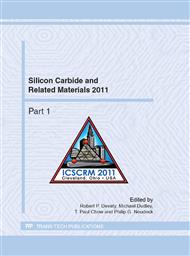p.485
p.489
p.493
p.497
p.501
p.505
p.509
p.513
p.517
Origin of the Warpage of 3C-SiC Wafer: Effect of Nonuniform Intrinsic Stress
Abstract:
Technique of bulk-like 3C-SiC film (up to 300 µm) growth on undulant-Si substrate is known to be very effective to reduce stacking fault density as well as that of other planar defects. However, freestanding 3C-SiC wafer shows anisotropic warpage involving large convex curvature in the direction perpendicular to the ridge of undulation ([110] direction), and slight concave curvature in parallel direction ([-110] direction), i.e. saddle shape. In this paper the origin of the warpage of the 3C-SiC wafer is investigated. Ex-situ curvature measurements and stress calculation reveal that large compressive intrinsic stress is generated during high-temperature growth process (1623 K) in both parallel and perpendicular directions. In order to investigate the intrinsic stress distribution along the [001] direction, a reactive ion etching (RIE) is conducted for the 3C-SiC on Si substrate to observe the dependence of the SiC/Si system curvature as a function of 3C-SiC thickness. This observation shows that the intrinsic stress component perpendicular to the ridge of undulation presents nonuniform distribution in [001] direction. The remarkable change in the intrinsic stress is observed in the 50 µm-thick region from SiC/Si interface. A finite element method simulation using the obtained intrinsic stress distribution clearly explains that the anisotropic warpage of SiC wafer is induced by the intrinsic stress distribution in quantitative manner. Microstructure change induced by stacking fault reduction process (stacking fault collision) would be the cause of the intrinsic stress variation.
Info:
Periodical:
Pages:
501-504
Citation:
Online since:
May 2012
Authors:
Keywords:
Price:
Сopyright:
© 2012 Trans Tech Publications Ltd. All Rights Reserved
Share:
Citation:


